Overview
Surprisingly little research exists about what workers do with their retirement savings when they take an action affecting their account—whether they continue to work for the same employer, leave one job for another job, or reach retirement.1 For many Americans, assets in defined contribution (DC) savings plans such as 401(k)s will account for a larger portion of retirement income than a traditional pension that pays a set monthly benefit, sometimes known as a defined benefit (DB) retirement plan. DC plan assets now account for 28% of all retirement plan assets.2
Workers and retirees make more decisions about how to manage and spend their DC savings, such as how and when to withdraw funds for retirement, than they do about their DB pension benefits. How retirees choose to preserve, reinvest, or spend their savings can make a big difference in how long savings last in retirement. Some uses of retirement savings may be more costly to retirees than others. For example, rolling savings that are held in an employer-sponsored 401(k) into an individual retirement account (IRA) might subject the savings to higher investment management fees than if the money were left in the employer’s plan, where institutional fee arrangements often keep costs lower. Prior work by The Pew Charitable Trusts demonstrates that even small differences in fees can have a large impact on savings.3
Workers who take their accounts in cash as a lump sum distribution when they leave a job, rather than keeping it where it is or rolling it over to an account with a new employer, might spend the cash—leaving them with less retirement savings than if the money had stayed in a retirement account. Conversely, keeping savings in retirement accounts can result in tax-free long-term growth of assets as investment returns compound with lower fees. Assets withdrawn before age 59 1/2 are also often subject to a 10% penalty in addition to income taxes.
This brief examines the common characteristics among people who took money from their accounts, and those who left their accounts untouched, during the 2014-16 time period. The research uses data from the University of Michigan’s Health and Retirement Study (HRS), a nationally representative survey that follows workers and retirees ages 50 and over (for information on the data and study methods, see the appendix).
Among the key findings:
- Lower-income households (under $25,000) are more than three times as likely to withdraw all of their savings than households with incomes of $100,000 or more. This may, in part, reflect rules allowing employers to cash out or force a transfer of small accounts when an employee leaves a company, because of the administrative cost of maintaining such accounts.
- Conversely, those who left some or all of their DC plan assets with an employer when leaving a job were more likely—when compared with those who did not leave any or all of their assets in place—to have a larger DC account balance and have a higher income. This finding could indicate that higher-income workers may be better able than lower-income workers to withstand financial pressures, such as a health or job crisis, without having to access their retirement savings.
- Individuals with high levels of unsecured debt (often credit card debt) more commonly withdrew the entire account balance than those with low or no unsecured debt.
- Workers who leave a job for a new employer are more likely to leave their savings with their prior employer’s plan than those who retired or otherwise left the workforce.
- Those who, upon leaving a job, rolled some or all of their DC account balances into IRAs were more likely— compared with those who did not roll over some or all of their DC account balances into IRAs—to have a bachelor’s or advanced degree, have a higher income, and be White. One possible conclusion to draw would be that lower-income workers and retirees, as well as people from non-White communities, may be more likely to need their savings immediately—as income, to pay down debt, or to deal with financial shocks such as a health crisis or a job layoff.
- Married or partnered respondents were much less likely than others to withdraw all their DC savings upon leaving a job, and more likely than others to roll some or all of their savings into an IRA. One possibility is that some single respondents may have faced the increased financial pressures that can be associated with living on one income.
- Those who owned an IRA in 2014 were significantly more likely than those who didn’t to roll some or all of their account balances into an IRA between 2014 and 2016, which would seem to make sense: Already owning an IRA makes it easier to roll money into the account than having to open a new IRA in order to find a home for the money.
- Pew’s analysis shows that decisions about retirement savings can vary with income, debt, race, and account balance size, among other factors. Certain policies or employer practices may be helpful when workers and retirees draw down their retirement savings, because they may lack information when they do so; perhaps they have not previously owned an IRA and hence may be less aware of IRA rollover options and fee structures. More financial education delivered at the point of decision-making about topics such as fees and plan and IRA options that preserve assets in retirement may be helpful. When feasible, it should be easy—even the default option—to keep assets in a low-cost retirement account whether that account is an employer plan or an IRA with low-fee investment options.
Survey respondents took a range of actions with their retirement savings accounts
This brief examines the population made up of people ages 50 and over who took one or more actions affecting their DC retirement savings accounts from 2014 to 2016 when they changed jobs or left an employer. About 80% of workers or retirees who took any action with any of their DC plans took a single action; another 18.6% took two actions, 1.3% took three actions, and less than 1% took four or more actions with their DC savings plans.
In the most common action, accounting for 30.7% of actions taken, DC account holders rolled some or all of the balance into an IRA (Table 1). The second-most common action, affecting 25.2% of account dispositions, involved withdrawing all the funds; some of these respondents may have subsequently transferred their withdrawn monies into an IRA without reporting the transfer to the HRS, which the data is unable to discern.4
Some employers allow departing employees to leave their savings in the employer’s retirement savings plans, leading to the third-most common action: 24.3% of account dispositions involved leaving some or all of the funds with a previous employer. But other employers close an employee’s account when the employee leaves the company—although some close only accounts with comparatively low balances—and require that the savings be drawn down or rolled into an IRA. Separating employees with low balances (under $5,000) are particularly likely to face this type of employer-initiated account closure.5 The HRS does not have information on how many respondents had the option of leaving their money with their previous employers versus being required to close the account. In any event, there is some evidence that most workers ages 60 and older who leave their monies with a previous employer withdraw it within five years.6
Finally, 19.8% of actions involving a DC account took the form of partial or scheduled withdrawals or rolling the account into an annuity for an immediate or future stream of payments.
These actions have implications for a person’s financial well-being. Assets that were left with the employer, rolled into an IRA, or transferred to other DC plans were still preserved as retirement assets, although fees and withdrawal rules might vary among these options. Taking money out of the retirement account may reflect a financial need or a lack of familiarity with alternative options.
Table 1
Disposition of Defined Contribution Accounts, 2016
Most frequent action rolled some or all of savings into an IRA
| Disposition of accounts | Percent of account dispositions |
|---|---|
| Rolled into an IRA | 30.7% |
| Withdrew all | 25.2% |
| Left some or all of savings in the plan or transferred to a new plan | 24.3% |
| Receiving benefits based on annuitized/partial withdrawals of some or all of the account | 19.8% |
Source: The Pew Charitable Trusts, staff analysis of the University of Michigan Health and Retirement Study, 2016 Wave © 2021 The Pew Charitable Trusts
Retirees took partial or full withdrawals, or converted their balances to annuities, more frequently than those who were still working
As might be expected, taking partial or scheduled withdrawals or annuitizing some of the account balance was more common among respondents who were completely retired, regardless of age, than among those still in the workforce (Figure 1).
But workers who were partly retired withdrew the entire account balance more commonly than retirees.7 Those under age 59 1/2 (24.1% of those withdrawing all their money, not shown in Figure 1) would have been subject to a 10% penalty for early withdrawals if they did not subsequently roll the money into an IRA or another retirement account.8
Those still in the workforce (“not retired”) left some or all of the account with a previous employer, or transferred it to another retirement account, more commonly than retirees did.
Similar proportions of workers and retirees rolled some or all of retirement savings into an IRA.
Disposition of assets varies significantly by demographic characteristics
Choices about retirement savings vary by race, ethnicity, education, and marital status. Rollovers from workplace 401(k) accounts into IRAs upon leaving a job were more frequent among White respondents and among those who had a bachelor’s or advanced degree (Figure 2). Conversely, withdrawing the entire account balance upon leaving a job was more common among Hispanic or non-White/non-Hispanic respondents and among those who had not completed college. Gender is not a significant factor in how workers dispose of their DC account balances (results not shown).
More education can translate into higher incomes,9 which can, in turn, lead to more savings and wealth and better access to affordable credit. Higher earners, and individuals with more wealth, have more options than lower earners do when faced with a financial shock such as a job loss or a health crisis. Higher levels of schooling may also lead to advanced mathematical skills and greater exposure to financial concepts, which may be helpful in retirement planning.10 These factors may make it easier for those with college degrees to deal with unexpected expenses in ways other than drawing down retirement savings or taking on additional debt. On the other hand, IRA providers may also try to sell high-fee investment products to individuals with higher savings account balances, which offer the providers greater opportunities for profit.
Marital status appears to have an important influence on account disposition choices (the analysis does not consider a spouse’s or partner’s account disposition choices). Withdrawing all retirement savings was more common among respondents who were not part of a couple—those who had never married or were separated, divorced, or widowed—than among those who were married or had partners (Figure 3). Married or partnered respondents were more likely to roll some or all of their savings into an IRA. One possible explanation would be that respondents who were not part of a married (or otherwise partnered) couple may have faced increased financial pressures associated with living on one income, or from divorce or widowhood.11
Smaller DC account balances were fully withdrawn at higher rates
About 30% of actions taken with smaller DC account balances—under $25,000—involved withdrawing the entire balance upon leaving a job, compared to 13.6% of balances between $25,000 and $99,999 and about 7.8% of actions taken with account balances of $100,000 or more (Figure 4). These results are not entirely surprising, because for balances at the very low end of the first bracket—under $1,000—plan sponsors (employers) can issue a check to the account holder, closing the account even if the departing employee makes no request to do so.12 Most plans, however, allow departing employees who have more than $5,000 invested in their 401(k)s to leave their money in the plan. For likely similar reasons to those outlined above, the share of disposition choices that entailed leaving some or all of the account with the previous employer or transferring savings to another DC plan rose with greater account balances. Respondents’ propensity to roll some or all of their account balances into an IRA did not vary much with account size, although it was somewhat higher among those with plan assets under $25,000, perhaps because of rules that, for amounts between $1,000 and $5,000, allow plan sponsors to make an immediate distribution into an IRA selected by the plan or by the account holder.13
More lower-income households withdrew their entire DC balances than higher-income households
Withdrawing the entire balance occurred more frequently (43.1%) among respondents with total household incomes below $25,000 than among households with higher incomes (Figure 5). Leaving part or all of the money with a previous employer or transferring the balance to another retirement savings plan was more common among respondents with household incomes of $100,000 and up than other income groups. Results for the respondents’ own earnings (as opposed to household earnings; not shown) exhibited similar patterns. One possible reason: In some cases, lower-income workers and retirees may have needed their savings immediately— as income, to pay down debt, or to deal with financial shocks such as a health crisis or a job layoff.14 Additionally, as noted above, employers are permitted to cash out or force a transfer of small accounts because of the administrative cost of maintaining such accounts.
The median household income of respondents who withdrew their entire account balance was $51,860 (Table 2). Median incomes were higher for respondents who rolled some or all of their account into an IRA or who were taking partial or scheduled withdrawals from their accounts. The highest median incomes, of $113,024, belonged to respondents who left part or all of their money in tax-sheltered retirement savings, by leaving it with their previous employer or transferring it to another DC plan.
Table 2
Median Household Income of Workers by Account Disposition, 2016
Median household incomes were higher for those who left part or all of their balances with the previous employer, and lower for those who withdrew the balance
| Median household income | |
|---|---|
| Withdrew all/took a lump sum | $51,860 |
| Receiving benefits/withdrew some/purchased annuity | $74,610 |
| Rolled account into an IRA | $83,000 |
Left in the account/combined or transferred to another retirement account $113,024
Source: The Pew Charitable Trusts, staff analysis of the University of Michigan Health and Retirement Study, 2016 Wave © 2021 The Pew Charitable Trusts
Previous IRA ownership appears to ease rolling DC accounts into IRAs
Behavioral factors such as convenience may influence the decision to roll DC plan money into an IRA and contribute to understanding the finding that IRA rollovers increased significantly among those who had already had an IRA (Figure 6). The data shows that 41% of IRA rollovers from 2014 to 2016 were made by somebody who had already set up an IRA by 2014. By comparison, only 17.5% of rollovers were made by those who did not already have an IRA by 2014.
Those with an IRA two years earlier were also less likely to be receiving benefits or to have withdrawn all or some of their DC account balance.
Existing IRA holders were also more likely to have left their money in their DC account with their previous employer even when rolling funds into their IRA would have been relatively easy. Those who left savings with their previous employer might have done so because of inertia, which frequently characterizes decisions about retirement saving.15
High levels of unsecured debt increase propensity to withdraw the entire DC balance
People with unsecured debt—that is, debt not collateralized by homes or cars—of between 10% and 40% of income in 2014 had the highest propensity to withdraw the entire account balance over the next two years (Figure 7). At the highest ratios of debt to income (40% and more), individuals were more likely than those with lower ratios to keep their money in tax-preferred retirement accounts, either leaving it with a previous employer or rolling it into an IRA or another retirement account. One possible explanation is that, in general, amounts of debt over $20,000 (not shown) may include personal loans or student loans at relatively low interest rates, and individuals may be less inclined to use retirement savings to pay off lower-interest than higher-interest debt.16
Recommendations
The analysis suggests that some policies and practices aimed at increasing understanding of key DC plan decisions may help workers who are on the cusp of retirement or changing jobs preserve their retirement assets. To the extent that some decisions are driven by a lack of information, financial counseling about topics such as fees and plan options that preserve assets in retirement may be helpful, particularly if targeted to participants at the point of making important decisions about their retirement savings.
Employers may have a role to play in helping older employees understand plan and IRA options. Making it easier for workers to leave their funds in the workplace plan—rather than requiring the removal of funds upon departure from the firm—could provide attractive options to more retirees. In addition, employers could offer opportunities for emergency savings, whether in a retirement plan or alongside one, as well as counseling on the importance of emergency savings as part of a workplace financial wellness program.
Policymakers and analysts may also want to explore permitting default options at retirement; that is, policies that automatically assign a worker to an asset-preserving strategy but allow the worker to opt out. For example, more employers could allow workers to leave their retirement savings in the employer’s plan in the absence of a decision by the retiring employee. Another type of default could automatically roll a worker’s retirement savings into a low-fee IRA that mirrors the investment allocations that the participant held in the employer-provided plan.
Conclusion
Today, 60% of workers have access to employer-provided defined contribution plans, and 43% participate in one.17 In DC plans, the participants must decide what to do with their accumulated savings when they retire. A wrong decision at retirement can mean tens of thousands of dollars in lost savings, in lost opportunities for future growth, or in avoidable taxes. This brief provides a baseline understanding on who makes what decisions about their retirement savings because people differ in some key ways regarding their choices. This analysis can help identify the groups who are at a greater risk of lower retirement income as a result of these decisions and provides a basis for policy recommendations.
Appendix: Data and methods
The Health and Retirement Study (HRS) is a longitudinal study, managed by the University of Michigan, that follows Americans ages 50 and over as they retire and age.18 It has been conducted every two years since 1992. The HRS is a rich mine of information on older Americans’ finances, work histories, demographic characteristics, health, and retirement savings.
This report uses the 2014 and 2016 waves of the HRS. Population is found by applying HRS respondent weights to the observations. The total sample, including missing observations for some variables, is 1,956 unweighted and
157,770 weighted respondents who took an action with their DC accounts during the two years before each wave.
Survey panel demographic characteristics
Among the survey panel ages 50 and over, slightly more than a third—37.5%—were under age 59 1/2 (Figure A1). Those under age 59 1/2 may be subject to the 10% penalty for early withdrawals if they don’t subsequently roll the money into an IRA or another retirement account, and this may reduce the net amount available from the withdrawal.19 Almost three-quarters—72.9%—were white and non-Hispanic. About 31.4% of the population had a bachelor’s or advanced degree, while 60.9% had a high school degree or less. About two-thirds of the population were married or lived with a partner.
Figure A1
Demographic Characteristics of the Survey Population, 2016
| Percent of survey population ages 50+ | |
|---|---|
| Age | |
| Ages 50 to 59 1/2 | 37.6% |
| Ages 59 1/2 and over | 62.4% |
| Gender | |
| Male | 48.1% |
| Female | 51.9% |
| Race/ethnicity | |
| White, non-Hispanic | 72.9% |
| Non-white, non-Hispanic | 16.6% |
| Hispanic | 10.5% |
| Education | |
| High school or less | 60.9% |
| Some college | 7.6% |
| College degree | 19.6% |
| Advanced degree | 11.8% |
| Marital status | |
| Married/partnered | 66.3% |
| Separated/divorced | 15.7% |
| Widowed | 9.9% |
| Never married | 8.1% |
Source: The Pew Charitable Trusts, staff analysis of the University of Michigan Health and Retirement Study, 2016 Wave © 2021 The Pew Charitable Trusts
HRS retirement status variables
The HRS has two questions that can be used to assess retirement status. The first asks about labor force status while the second asks about retirement status. For both questions, very similar shares of respondents reported that they were retired: 39.3% and 39.4%, respectively (Figure A2). For other dimensions of work and retirement status, such as being “partly retired” or “not retired,” the results are not quite as close, perhaps because the question for labor force status included additional options such as part-time work, disability, and not being in the labor force. Both the labor force and retirement status variables include an option for “partly retired”: 8.6% gave this answer for the labor force status question, compared with 12.6% of those answering the retirement status variable. When responding to the question about retirement status, about 48% of respondents reported that they were “not retired.” A somewhat analogous measure can be made from the labor force status variable by combining responses for full-time workers, part-time workers, and unemployed workers; this produces a total of 45.9% (answers of “partly retired” are excluded from the figures in both variables). This analysis uses the retirement status variable in cross tabulations, mainly because the fewer categories preserve cell counts and statistical validity.
Figure A2
Two HRS Variables: Labor Force and Retirement Status of the Survey
Population, 2016
| Percent of survey population ages 50+ | |
|---|---|
| Labor force status | |
| Works full time | 36.8% |
| Works part time | 6.7% |
| Unemployed | 2.4% |
| Partly retired | 8.6% |
| Retired | 39.3% |
| Disabled | 2.7% |
| Not in the labor force | 3.5% |
| Retirement status | |
| Not retired | 48.0% |
| Retired | 39.4% |
| Partly retired | 12.6% |
Source: The Pew Charitable Trusts, staff analysis of the University of Michigan Health and Retirement Study, 2016 Wave © 2021 The Pew Charitable Trusts
Where appropriate, Pew analyzed workers and retirees separately, because workers and retirees have very different motivations regarding the disposition of their retirement savings accounts.
HRS account disposition variables
Two HRS questions investigate what older workers do with their 401(k) plans. Pew combined both questions into a single variable to capture decisions that respondents made about their DC plan balances and to amass sufficient sample sizes for meaningful results. The first question was asked of individuals who stayed in the same work or retirement status in the previous and current waves—that is, for the past two years—but who no longer had the retirement savings plan they reported in the earlier wave.20 The second question was asked of individuals who left the employer they reported in the earlier wave, either by changing jobs or by retiring from the workforce. The two questions offered respondents many identical options: roll the balance into an IRA, withdraw the entire balance, withdraw some of the balance, or roll the balance into an annuity. Unlike the first question, however, individuals answering the second question may still have the retirement savings plan associated with the previous employer, and they may even have left their retirement savings account with the employer reported in the previous wave.21 There is no overlap among respondents to the two questions. The results are therefore interpreted here as outcomes among respondents who took any action with their plans.
The HRS allowed people to identify multiple DC plans they had with an employer, as well as multiple actions they might have taken with each plan’s assets. For example, respondents could have answered that they had two DC plans, and that for the first plan they annuitized the entire balance and for the second plan they withdrew some of the savings and left the remaining balance with the previous employer.
About 88.9% of respondents to the first question took a single disposition action with their DC plan balance, while another 11.1% took two actions with their plan balance. About 78.6% of respondents to the second question took a single action with their plan balance, and a further 20.3% took two actions. Fewer than 1% of either group reported that they took three actions with their plans. When both questions are considered together, 80.0% of those who took action with their DC plan(s) took a single action, 18.6% took two actions, 1.3% took three actions, and less than 1% took four or more actions.
In this study Pew treated each plan and each corresponding action as a distinct observation in order to try to capture the full range of account holders’ decisions and to increase the number of observations. Thus, results reported here are best interpreted as “dispositions” or “actions taken,” except for the “withdrew all” category, which doesn’t leave scope for additional actions.
Unfortunately, the HRS has no data on which respondents were allowed to leave their savings with their former employers versus being compelled to move their savings out of the employer’s plan. The survey also has little data on workers’ participation in workplace retirement plans through second jobs, which are sometimes an important part of workers’ overall financial picture.
Endnotes
- See, for example, S. Banerjee, “Take It or Leave It? The Disposition of DC Accounts: Who Rolls Over Into an IRA?,” EBRI Notes 35, no. 5 (2014).
- Investment Company Institute, “Defined Contribution Plan Participants’ Activities, First Three Quarters of 2020” (2020), https://www.ici.org/pdf/20_rpt_recsurveyq3.pdf. “All retirement plan assets” in the study include DC and DB plans, individual retirement accounts (IRAs), and annuities.
- The Pew Charitable Trusts, “How Fees Affect Retirement Savings Over Time,” accessed Dec. 7, 2020, https://www.pewtrusts.org/en/research-and-analysis/data-visualizations/2018/how-fees-affect-retirement-savings-over-time?track=splash&slide=home. For example, consider two near-retirees who have each saved $725,000 in their 401(k) plans and, in retirement, plan to withdraw $3,500 a month. A retiree who rolls his or her savings into a low-risk fund with annual operating fees of 1.25% would exhaust the savings after 18 years in retirement. A second retiree, who chooses a low-risk fund with annual operating fees of 0.04%, would still have $43,500 at the end of 20 years.
- A person making a withdrawal from a 401(k) or IRA has 60 days to roll the funds into an IRA before incurring income tax liability or penalties.
- Most plans allow separating employees who have $5,000 of more invested in their 401(k)s to leave it in the plan. If the separating employee’s balance is between $1,000 and $5,000, the plan can make an immediate distribution into an IRA it selects, unless the separating employee elects to receive a lump sum or to roll it over to an IRA of his or her choosing. If the balance is under $1,000, a plan sponsor can issue a check for the lump sum to the separating employee. See U.S. Department of Labor, “FAQs About Retirement Plans and ERISA,” https://www.dol.gov/sites/dolgov/files/ebsa/about-ebsa/our-activities/resource-center/faqs/retirement-plans-and-erisafor-workers.pdf.
- D.C. Proctor and J.A. Young, “Retirement Distribution Decisions Among DC Participants” (Vanguard Center for Investor Research, 2019), https://institutional.vanguard.com/iam/pdf/CIRRDDC.pdf. Account holders ages 59 ½ and older can withdraw funds from DC accounts or IRAs without penalty.
- As noted earlier, it is possible that some withdrawals were subsequently rolled into an IRA, but the dataset does not allow us to determine whether this is the case. According to one recent study, about 80% of the dollars distributed through nonrollovers went to taxpayers ages 59 or older.
- U.S. Internal Revenue Service, “Retirement Topics—Exception to Tax on Early Distributions,” accessed Dec. 7, 2020, https://www.irs.gov/retirement-plans/plan-participant-employee/retirement-topics-tax-on-early-distributions. For some younger individuals making withdrawals, certain exceptions to the 10% penalty may have applied; for example, withdrawals made for medical expenses or by those who left an employer after age 55. Workers who take early withdrawals for medical or educational reasons or to finance the purchase of a first house may not be subject to the 10% penalty. In addition, workers who leave a job at age 55 are not subject to the penalty.
- See U.S. Bureau of Labor Statistics, “Unemployment Rates and Earnings by Educational Attainment, 2019,” accessed Dec. 7, 2020, https://www.bls.gov/emp/tables/unemployment-earnings-education.htm. See also A.P. Carnevale, S.J. Rose, and B. Cheah, “The College Payoff: Education, Occupations, Lifetime Earnings” (Georgetown University Center on Education and the Workforce, 2011), https://cew.georgetown.edu/cew-reports/the-college-payoff. Note that the differences in lifetime earnings may in part reflect the underlying capabilities and characteristics of those individuals obtaining additional formal education and cannot be wholly attributed to the degree itself.
- A. Lusardi and O.S. Mitchell, “Financial Literacy and Planning: Implications for Retirement Wellbeing,” in Financial Literacy: Implications for Retirement Security and the Financial Marketplace (Oxford: Oxford University Press, 2011).
- Those who were married or in a partnership were more likely (21.1%) to take multiple actions with their plans than those who were never married or were separated, divorced, or widowed (14.4%) (p<0.0001).
- As noted above, some respondents may have been retired for some time and may have depleted their account balances over a number of years to reach low dollar amounts.
- U.S. Department of Labor, “FAQs About Retirement Plans and ERISA.”
- The Pew Charitable Trusts, “Financial Shocks Put Retirement Security at Risk” (2017), https://www.pewtrusts.org/en/research-andanalysis/issue-briefs/2017/10/financial-shocks-put-retirement-security-at-risk.
- J.J. Choi et al., “Saving for Retirement on the Path of Least Resistance” (Harvard University, 2005), https://scholar.harvard.edu/laibson/publications/saving-retirement-path-least-resistance.
- Unsecured debt in 2016 was not significantly associated with 2016 disposition outcomes and is not shown here. Moreover, it is difficult to interpret 2016 debt levels because some lower debt amounts reported in 2016 may reflect cases where retirement savings were used during the previous two years to pay down debt that had been high in 2014.
- U.S. Bureau of Labor Statistics, “National Compensation Survey: Employee Benefits in the United States, March 2020” (2020), https://www.bls.gov/ncs/ebs/benefits/2020/employee-benefits-in-the-united-states-march-2020.pdf.
- University of Michigan, “Health and Retirement Study,” accessed July 25, 2020, https://hrs.isr.umich.edu/about.
- U.S. Internal Revenue Service, “Retirement Topics.”
- Individuals in the first group (survey question W404) may be receiving benefits from their retirement savings account because they annuitized part or all of the balance or are taking partial withdrawals; they may have withdrawn all of the account balance; or they may have rolled some or all of the account balance into an IRA or into another retirement savings plan they hold. In some cases, the plan may still be “active” instead of “dead” because it was frozen or lost, but these outcomes are not included in the analysis. One option that is not available to individuals in the first group, given how this question is defined, is to have left their retirement savings account with their employer.
- Individuals in the second group (survey question W420) could have left the balance with the previous employer, if the plan permitted this. Or, they may be receiving benefits from their retirement savings account because they annuitized part or all of the balance or are taking partial withdrawals; they may have withdrawn all of the account balance; or they may have rolled some or all of the account balance into an IRA or into another retirement savings plan they hold. In some cases, the account balance was frozen or lost, but these outcomes are not included in the analysis.
"work" - Google News
May 18, 2021 at 01:56AM
https://ift.tt/2Qr45BH
How Employees Handle Their Retirement Savings During Work Transitions - The Pew Charitable Trusts
"work" - Google News
https://ift.tt/3bUEaYA
Bagikan Berita Ini

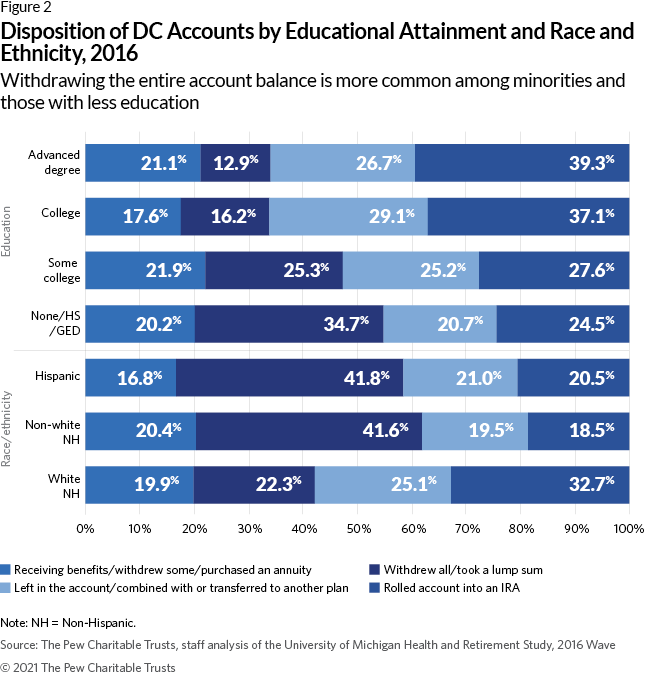
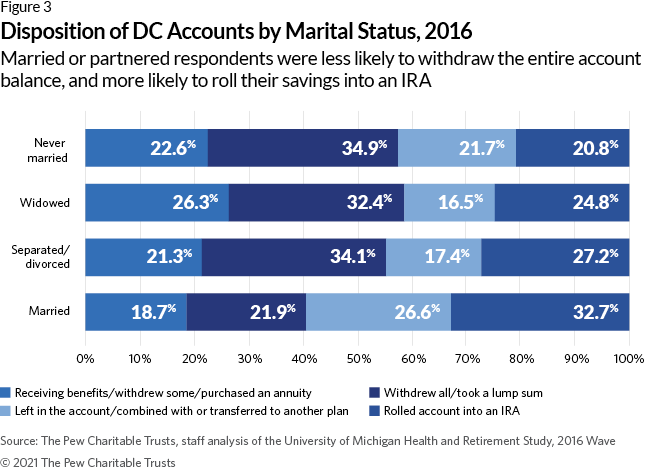
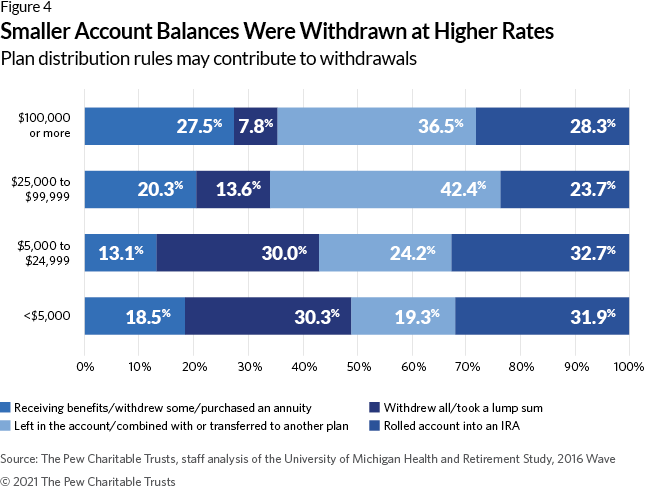
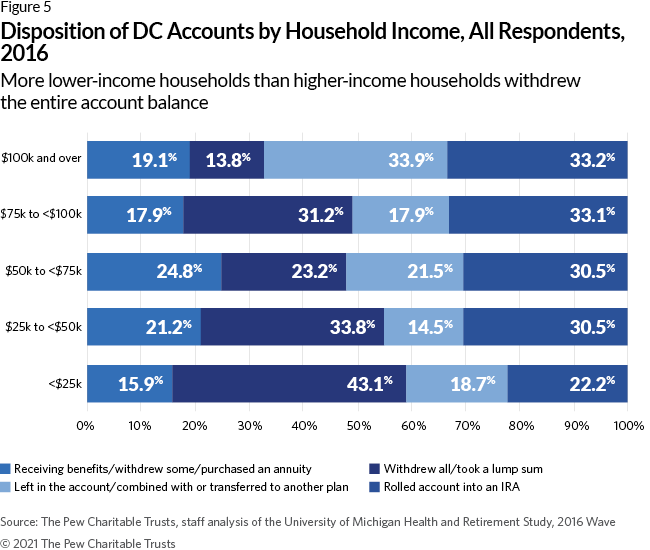
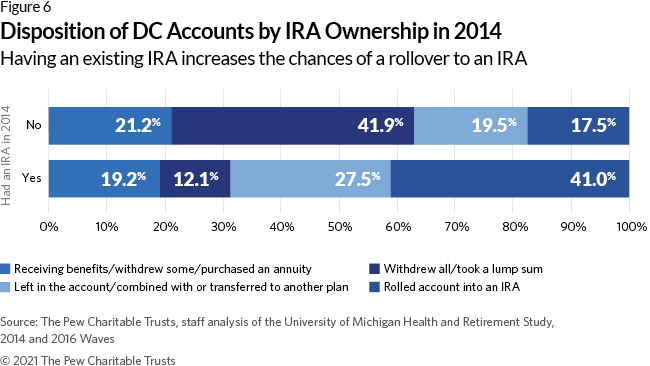
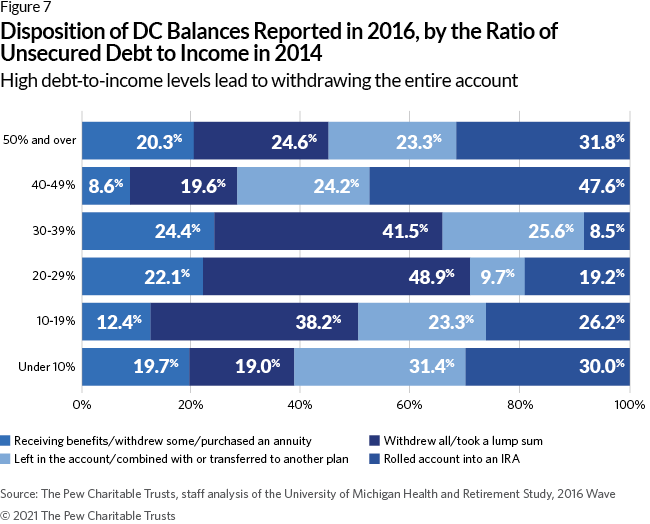















0 Response to "How Employees Handle Their Retirement Savings During Work Transitions - The Pew Charitable Trusts"
Post a Comment